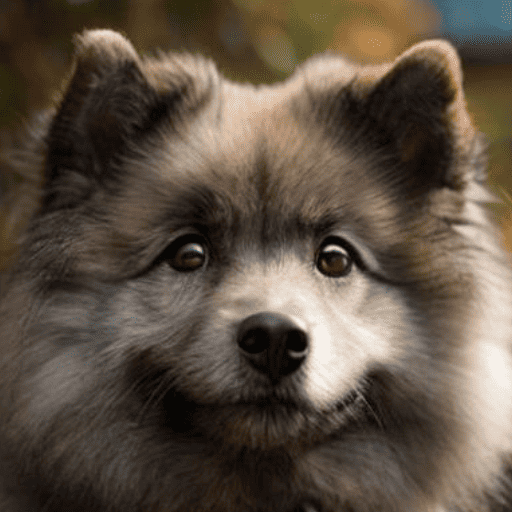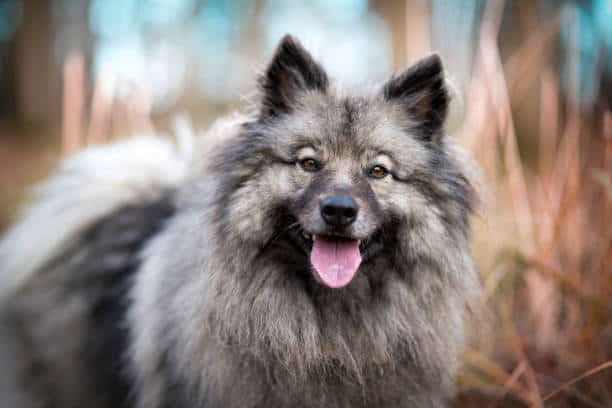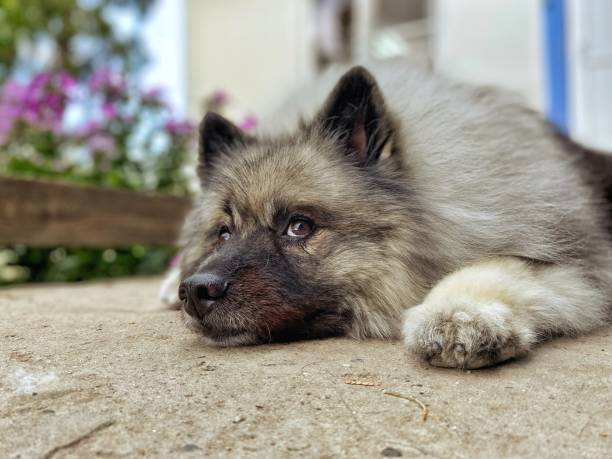The Keeshond, known for its charming personality and distinctive appearance, has a special place in the hearts of those who appreciate the spitz-type breeds. With a history that traces back to Dutch seafaring and a striking appearance, this breed has earned its reputation as a delightful and loyal family companion.

| Category (Explanation) | Breed Information |
|---|---|
| Year of Breed Conception | 17th century |
| Country of Origin | Netherlands |
| Weight (lbs & kg) (Male) | 35-45 lbs (16-20 kg) |
| Weight (lbs & kg) (Female) | 30-40 lbs (14-18 kg) |
| Coat Type | Double, plush |
| Color Variations | Grey, black, cream |
| Shedding Level (Low, Moderate, High) | Moderate |
| Height (cm & in) | 17-18 inches (43-46 cm) |
| Breed Size | Medium |
| Trainability (Low, Moderate, High) | High |
| Mental Needs (Low, Moderate, High) | Moderate |
| Intelligence Level (Low, Moderate, High) | High |
| Energy Level (Low, Moderate, High) | Moderate |
| Agility (Low, Moderate, High) | Moderate |
| Loyalty (Low, Moderate, High) | High |
| Playfulness (Low, Moderate, High) | Moderate |
| Exercise Needs | Regular exercise and mental stimulation |
| Guarding Proficiency (Low, Moderate, High) | Moderate |
| Sociability with Children (Low, Moderate, High) | High |
| Barking Level (Low, Moderate, High) | Moderate |
| Digging Tendency (Low, Moderate, High) | Low |
| Destructive Behavior (Low, Moderate, High) | Low |
| Drooling Level (Low, Moderate, High) | Low |
| Obedience Level (Low, Moderate, High) | High |
| Apartment Friendly (Yes/No) | Yes |
| Inherent Prey Drive | Low |
| Physical Risk to Others (Low, Moderate, High) | Low |
| Travel Fatality Risk (Low, Moderate, High) | Low |
| Allergen Potential | Low |
| Health Concerns (List of Common Health Concerns) | Hip dysplasia, heart issues |
| Average Life Expectancy (Life Expectancy in Years) | 12-15 years |
Woof Mastery is reader supported and our articles may contain affiliate links.
Instead of running third party ads that we have no control of we only use links from high-quality companies we are directly partnered with. Making use of these links come at no cost to you our reader, and in many cases have the extra benefit of discounted rates or sign up bonuses.
If you’re interested you can read more about our affiliate policy here.
We appreciate your support and always insure that the products and services we recommend are high-quality, helpful and relevant to the subject at hand!
The history of the Keeshond is closely linked to the Dutch, where they played a significant role as companions to sailors and as symbols of Dutch patriotism during political upheaval. Their name comes from a dog named Kees, who was a symbol of Dutch resistance in the 18th century.
Over the years, Keeshonds have transitioned from being working dogs on ships to becoming beloved pets in Dutch households. They’re known for their distinctive appearance, with a fox-like expression and luxurious mane.

What makes the Keeshond special is their charming personality and distinctive appearance. These dogs are known for their lively and affectionate nature, making them ideal family pets. Their history of loyalty and symbolism in Dutch culture makes the Keeshond truly exceptional.
Keeshonds, originating in the Netherlands, were historically used as barge dogs, watchdogs, and companions to sailors and merchants.
Their primary role included guarding ships, alerting to intruders, and providing companionship and cheerfulness to the crew.
Keeshonds are known for their affectionate, friendly, and cheerful personalities. They are often excellent watchdogs, being alert and vocal when necessary. These dogs are loyal to their families and enjoy being around people. They require regular exercise and mental stimulation to stay happy.
Keeshonds are known for their affectionate, friendly, and cheerful personalities. They are often excellent watchdogs, being alert and vocal when necessary. These dogs are loyal to their families and enjoy being around people. They require regular exercise and mental stimulation to stay happy.
Keeshonds have a distinct appearance with a fox-like face, erect triangular ears, and expressive dark eyes. Their double coat is thick and plush, with distinctive “spectacles” around their eyes. Coat colors are typically gray, black, and cream. Their tails are plumed and carried over their backs.
Keeshonds have a distinctive coat that typically combines shades of gray, cream, and black. These colors highlight their expressive and alert appearance. The Keeshond’s coat is not only visually striking but also reflects their lively and engaging personality. The combination of gray, cream, and black in their double coat adds to their overall charming and expressive presence. Keeshonds are known for their intelligent and alert nature, and their coat coloration enhances their distinctive look.
Keeshonds have a distinctive and captivating coat pattern that adds to their unique charm. The common coat pattern for Keeshonds is:
Agouti: Agouti coat patterns consist of bands of different colors along each hair, creating a wild and striking appearance. This unique pattern adds to the breed’s unique allure and individuality, making Keeshonds truly stand out in the canine world.
Keeshonds have a moderate shedding level. They are not heavy shedders, but they do experience year-round shedding with seasonal increases in spring and fall. Shedding can vary among individuals and is influenced by genetics, health, and coat care. Regular brushing with a slicker brush can help manage shedding by removing loose fur and keeping their coat in good condition.
Keeshonds have a beautiful double coat that requires regular grooming to keep it healthy and maintain their iconic appearance. Here are some grooming habits for this breed:
Brushing: Regular brushing is essential and should be done several times a week. Their thick undercoat requires a slicker brush or an undercoat rake. Bathing: Keeshonds do not require frequent baths, as their natural oils help maintain coat health. Bathing should only be done when necessary, using a dog-specific shampoo. Be sure to rinse thoroughly. Ears: Check and clean their ears regularly to prevent wax buildup or infections. Use a damp cotton ball or a veterinarian-recommended ear cleaning solution. Nails: Keep their nails trimmed to a comfortable length to prevent discomfort and maintain proper gait. Teeth: Dental hygiene is important. Brush their teeth regularly to prevent dental issues and bad breath. Dental chews or toys can also help.
Keeshonds have a moderate activity level and enjoy physical challenges. Here are key points to consider about their activity level:
Exercise Needs: They require daily exercise to stay happy and healthy. Activities can include daily walks, playtime, and even agility training. Energy Level: They have a moderate energy level and enjoy both active play and relaxation. Mental Stimulation: Provide mental stimulation through interactive toys and obedience training. Weather Consideration: Keeshonds can tolerate cold weather well but should be protected from extreme heat. Be cautious of exercise during hot weather.
Keeshonds are intelligent and sociable dogs. Here are some key points about their intelligence:
Trainability: They are intelligent and trainable, responding well to positive reinforcement methods. Problem-Solving: Keeshonds have good problem-solving abilities and enjoy mental challenges. Independence: They are sociable but can be independent thinkers. Work Ethics: They have a strong work ethic and were historically bred as watchdogs on barges. Social Intelligence: Keeshonds tend to be socially intelligent and form strong bonds with their families.
Training should focus on their intelligence and sociable nature.
Meeting the mental needs of Keeshonds is important for their well-being. Here are some considerations:
Social Interaction: They thrive on social interaction and being part of the family. Loneliness can lead to boredom or anxiety. Training and Obedience: Obedience training not only provides mental stimulation but also reinforces their bond with their owners. Consistency and positive reinforcement are key. Mental Stimulation: Engage them in activities that challenge their minds, such as puzzle toys or obedience training. Routine and Structure: Dogs thrive on routine and structure. Establishing a predictable daily routine can help them feel secure and reduce anxiety. Affection and Attention: Keeshonds thrive on human companionship and affection. Show them love and spend quality time together. Socialization: Early socialization is important to ensure they are comfortable around different people and animals. Safe Environment: Create a safe and comfortable environment at home where they can relax and feel secure. Consistency: Consistency in training and daily routines helps them feel more secure and confident in their environment.
Enter The Woof Mastery

Considering a Keeshond? Here’s what you should know:
Friendly Nature: Keeshonds are known for their friendly and sociable demeanor.
Grooming: Their double coat needs regular brushing to prevent matting.
Training: They are eager to please and respond well to positive reinforcement training.
Socialization: Early socialization is crucial for their confidence.
Keeshonds are generally low-risk dogs due to their friendly disposition:
Friendliness: Their sociable nature reduces the likelihood of aggression.
Socialization: Early socialization is essential to prevent shyness or fearfulness, although it’s rarely an issue with Keeshonds.
Training: Proper training minimizes the risk of unwanted behavior, although it’s rarely an issue with Keeshonds.
Keeshonds are known for their friendly and gentle nature, making them good companions for children:
Temperament: They are affectionate and sociable, enjoying the company of kids.
Size: They are a medium-sized breed, suitable for families.
Socialization: Early socialization helps them get along with children and other pets.
Training: Training is essential to ensure they behave appropriately around kids.
Keeshonds are generally capable swimmers, but their swimming ability can vary:
Size: Their size and strong build are advantageous for swimming, but supervision is still necessary.
Comfort Level: Some may enjoy swimming, while others may be more cautious. Gradual introductions can help build their confidence.
Life Vest: Consider using a canine life vest, especially in open water or deep pools.
Safety Precautions: Be aware of potential hazards, such as strong currents, and never leave your dog unattended near water.
Keeshond puppies are intelligent and eager to please. Here are some tips for training them:
Training your Keeshond puppy is a wonderful way to build a strong bond with them.
Keeshonds, known for their distinctive appearance, are friendly and tend to be vocal. Their vocalizations include:
Understanding their vocal tendencies is important for Keeshond owners.
Keeshonds thrive in homes filled with warmth, companionship, regular social interaction, and a consistent routine. Providing for their specific needs contributes to their happiness and well-being.
Challenges:
When it comes to travel fatality risk for Keeshonds, thoughtful consideration of potential constraints is essential to ensure a safe and enjoyable journey for both you and your furry friend:
By addressing these potential constraints and taking necessary precautions, you can help ensure the safe travel of your Keeshond, minimizing travel-related risks and creating a positive journey experience for both you and your lively companion.
Keeshonds may be prone to specific health concerns. While not all individuals will experience these issues, it’s essential for Keeshond owners to be aware of potential health problems and work with veterinarians to maintain their pets’ well-being. Common health concerns in Keeshonds include:
Regular veterinary check-ups, a balanced diet, proper exercise, and responsible breeding practices can help mitigate some of these health concerns. It’s crucial for Keeshond owners to work closely with their veterinarians to monitor their pets’ health and address any issues promptly.
Proper nutrition is crucial for the health and well-being of Keeshonds. Here are some nutritional habits and best practices to consider for this breed:
Breed-Specific Laws (BSL): Keeshonds may be subject to breed-specific laws (BSL) in certain areas. These laws are often enacted at the local or municipal level and can vary widely from one jurisdiction to another.
Types of Restrictions: The specific restrictions imposed on Keeshonds under BSL can include mandatory spaying/neutering, special licensing, liability insurance requirements, muzzling in public, and, in some cases, bans on ownership. The severity of these restrictions depends on local regulations.
Rationale for BSL: BSL is typically implemented based on concerns about public safety and perceived risks associated with specific breeds, often due to incidents involving dog attacks. While Keeshonds are not inherently aggressive, they can be affected by BSL due to their physical resemblance to breeds that are sometimes included in these laws.
Controversy: It’s important to note that BSL is a controversial topic. Critics argue that it unfairly targets breeds rather than addressing individual dog behavior and that responsible ownership and training should be emphasized instead of breed-specific restrictions.
Local Regulations: To determine if there are breed-specific laws or restrictions regarding Keeshonds in your area, you should check with your local animal control or government authorities. Be aware of and comply with any local regulations to ensure that you are in compliance with the law while owning a Keeshond.
Woof Mastery is reader supported and our articles may contain affiliate links.
Instead of running third party ads that we have no control of we only use links from high-quality companies we are directly partnered with. Making use of these links come at no cost to you our reader, and in many cases have the extra benefit of discounted rates or sign up bonuses.
If you’re interested you can read more about our affiliate policy here.
We appreciate your support and always insure that the products and services we recommend are high-quality, helpful and relevant to the subject at hand!
Myth 1: Keeshonds are Aloof and Distant
Myth 2: They Shed Only a Little
Myth 3: Keeshonds are Only Suitable for Cold Climates
Myth 4: They Are Not Good with Children
Myth 5: Keeshonds Cannot Be Trained
Myth 6: They Are Only Good for Experienced Owners
Myth 7: Keeshonds Don’t Need Regular Exercise
Myth 8: They Are Not Playful
Myth 9: Keeshonds Cannot Live in Apartments
Myth 10: They Are All the Same in Size
These myths highlight the importance of understanding the individual characteristics of Keeshonds and dispelling common misconceptions. Responsible ownership, proper care, and positive training contribute to a positive and enriching relationship with this lively and affectionate breed.
These enchanting Keeshond mascots, including Frosty Charmer, Keen Explorer, and Cosmic Fluff, embody the breed’s charm and continue to be celebrated symbols in their respective contexts.
The Keeshond holds cultural significance in various contexts:
While there may not be as many famous Keeshond owners as there are for other dog breeds, here are a few notable individuals who have been associated with Keeshonds:
Keeshonds, like many other dog breeds, have faced several threats and challenges over the years. Some of the significant threats and issues that have affected the breed include:
The Keeshond is believed to have been developed from a combination of various breeds, with the primary ancestors being the Samoyed, Norwegian Elkhound, and Pomeranian. The breed’s development occurred over several decades, with influences from different regional strains and breed types. The specific breeds and strains that contributed to the Keeshond’s development include:
Keeshonds epitomize the essence of cherished family companions. With their unwavering loyalty and affection, they seamlessly integrate into our lives, providing not only security but also heartfelt devotion. As excellent watchdogs, their alert instincts further solidify their role as guardians of our homes.
Their friendly and outgoing nature makes them perfect playmates for families with children, effortlessly adapting to various living conditions while demanding only moderate grooming. Their fluffy coats and distinctive markings add a touch of elegance to every household. Their versatility is a testament to their adaptability, transitioning effortlessly from beloved family pets to delightful working dogs.
Above all, these dogs offer an unparalleled gift—profound and unwavering love. They become more than pets; they become treasured family members, enriching our lives with their unwavering companionship and forging an unbreakable bond that lasts a lifetime.
Now, we invite you to discover the incredible love and devotion that this remarkable breed has to share. Bring a Keeshond into your life and experience the enduring joy and companionship they bring.